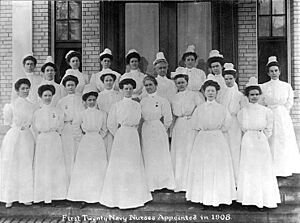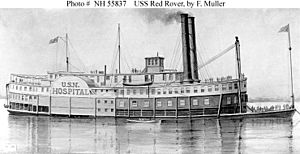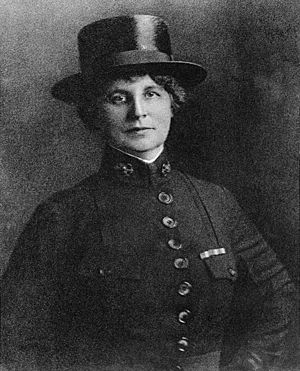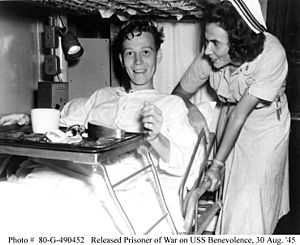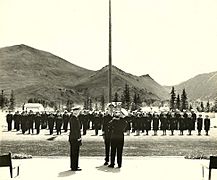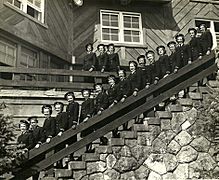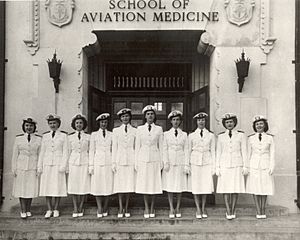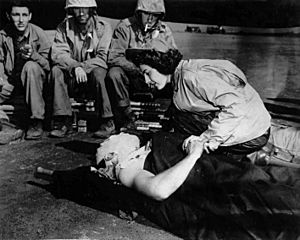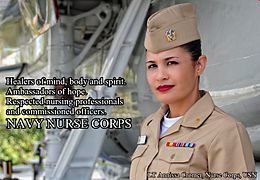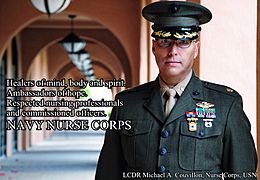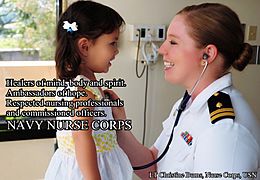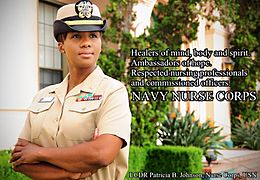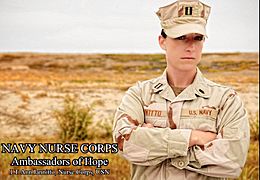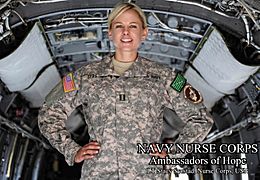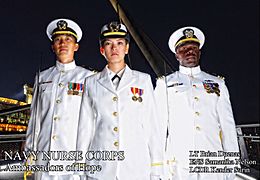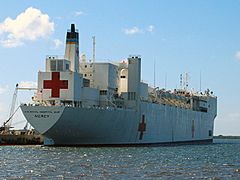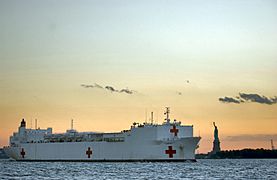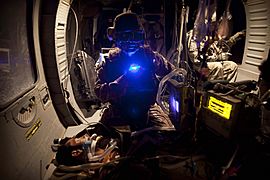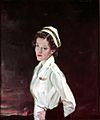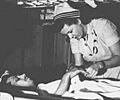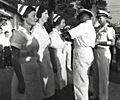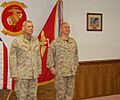United States Navy Nurse Corps facts for kids
Quick facts for kids United States Navy Nurse Corps |
|
|---|---|
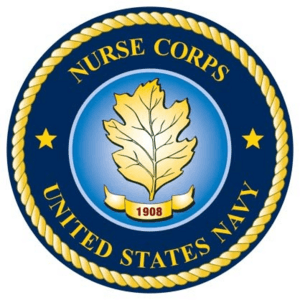
Seal of the United States Navy Nurse Corps
|
|
| Founded | 1908 |
| Country | |
| Branch | |
The United States Navy Nurse Corps was officially created by the U.S. Congress in 1908. However, women had been working as nurses on Navy ships and in Navy hospitals for almost 100 years before that. The Nurse Corps was made up only of women until 1965.
Contents
- Early Days of Navy Nursing
- The Sacred Twenty: 1908–1917
- Navy Nurses in World War I
- Between the World Wars
- Navy Nurses in World War II
- Navy Nurses in Korea
- Navy Nurses in Vietnam
- Navy Nurses Today
- Modern Nurse Corps Structure
- Nurse Corps Insignia and Badges
- Leaders of the Navy Nurse Corps
- Ships Named After Navy Nurse Corps Officers
- Other Ships Named After Nurses
- Images for kids
In 1811, a man named William P.C. Barton was the first to suggest that female nurses should work in naval hospitals. But it took a long time for this to happen. On June 19, 1861, the Navy Department finally created a special role called Nurse. This role was first filled by junior enlisted men.
During the American Civil War, several African American women worked as paid nurses on the hospital ship Red Rover. This ship was used in the Mississippi River area. Some of these brave nurses were Alice Kennedy, Sarah Kinno, Ellen Campbell, and Betsy Young. Volunteer nuns from the Catholic Sisters of the Holy Cross also served as nurses on the ship.
Later, during the 1898 Spanish–American War, the Navy hired a few female nurses to work in hospitals on land. They also sent trained male nurses to sea on the hospital ship Solace.
The Sacred Twenty: 1908–1917
After the Nurse Corps was officially started in 1908, twenty women were chosen to be the very first members. They were sent to the Naval Medical School Hospital in Washington, D.C. The Navy did not provide them with a place to live or food. So, these determined nurses rented their own house and cooked their own meals.
Over time, these first twenty nurses became known as "The Sacred Twenty". This is because they were the first women to formally serve in the U.S. Navy. The "Sacred Twenty" included important figures like Josephine Beatrice Bowman, Lenah H. Sutcliffe Higbee, and Esther Voorhees Hasson. These women helped lead the Nurse Corps in its early years.
The Nurse Corps slowly grew to 160 members before World War I. Nurses helped train local people in U.S. overseas areas. They also trained the Navy's male medical staff. In 1913, Navy nurses worked on ships for the first time, on the Mayflower and Dolphin. Permanent jobs on ships began in 1920 when the Relief hospital ship started service with Navy nurses on board.
When the United States joined World War I, the Nurse Corps grew a lot. Many new nurses joined, both regular and reserve members.
In 1917–1918, the Navy sent five hospital units to France, Scotland, and Ireland. Navy nurses also worked in special teams close to the battle lines. Some of these teams even helped the United States Army during intense fighting in 1918. They worked in tough conditions far from regular hospitals.
During the war, 19 Navy nurses died while on duty. More than half of them died from the flu pandemic of 1918. Three of the four Navy Cross medals given to wartime Navy nurses were awarded after their deaths. These nurses bravely gave their lives helping patients during the flu outbreak. One of them was Lillian Marie “Lillie” Murphy. She worked day and night until she got sick and died.
The fourth nurse to receive the Navy Cross was Lenah H. Sutcliffe Higbee. She was the second leader of the Nurse Corps and the first living woman to get this medal. In 1945, a fighting ship, the USS Higbee, was named after her. This was the first time a U.S. Navy fighting ship was named after a woman.
By the end of the war in November 1918, over 1,550 nurses had served in Naval hospitals at home and overseas. After the war, some Navy nurses helped bring troops home from Europe on transport ships.
Between the World Wars
After World War I, the number of nurses in the Corps went down. By 1935, there were only 332 nurses. But the Corps still made progress. New training courses were added in areas like diet therapy, mental health, physical therapy, and anesthesia. These new skills helped nurses gain more respect in the Navy. Even though they were treated like officers, nurses did not officially become commissioned officers until World War II.
During this time, nurses also gained the right to retire with pay for long service or disability. They also started serving on Navy hospital ships more regularly. Besides caring for Navy personnel, nurses helped during natural disasters. They also helped evacuate families from China in 1937 when there was war there.
As World War II approached, the Nurse Corps grew again. By November 1941, there were almost 800 active duty nurses and over 900 reserve nurses. By the end of the war, there were 1,799 active nurses and 9,222 reserve nurses. They were spread across six continents.
For a long time, African-American nurses were not allowed in the Navy. But in 1945, Phyllis Mae Dailey became the first black nurse accepted into the Navy Nurse Corps. Other African-American nurses like Edith DeVoe and Eula L. Stimley soon followed. These women were the first African-American women to serve as nurses in the Navy during World War II.
Navy nurses were on duty during the Japanese attack on Pearl Harbor, Kāneʻohe Bay, the Philippines, and Guam. They also served aboard the hospital ship Solace. Their work was very important in saving lives and preventing more injuries. The nursing profession was seen as so important that it was placed under the War Manpower Commission.
Even with a shortage of nurses, the Navy kept its high standards. Nurses received advanced training in many areas, including surgery, orthopedics, and mental health. They helped soldiers deal with stress from battle, which was then called "shell-shock." Nurses also had the important job of training hospital corpsman. These young men often had no medical experience. Nurses taught them everything they needed to know to work on fighting ships and invasion beaches, where nurses were not yet officially assigned.
In the Pacific, Navy Nurses were the first American women sent to islands north of New Caledonia, like Efate in the New Hebrides. There, they cared for wounded soldiers and Marines from the long Guadalcanal Campaign. Nurses were also stationed in places like New Zealand, Australia, Guam, Saipan, Iwo Jima, and Okinawa. Their goal was to stabilize patients so they could be moved to larger hospitals further away.
In Europe, Navy nurses served in England and Italy. They also worked in North and South America, including Trinidad, Panama, and Brazil. Some Navy nurses were even stationed in Africa.
Within the contiguous United States, Navy nurses worked at 263 different locations. These included large hospitals like USN Hospital San Diego and smaller convalescent hospitals. One interesting place was the USN Convalescent Hospital at the Sun Valley Lodge in Idaho. This lodge was a famous resort for celebrities. But during the war, it was turned into a hospital to help wounded service members recover.
On hospital ships, Navy nurses followed the fleet during attacks. Eventually, they were allowed to go to the beaches with the fighting men to pick up the wounded. Many hospital ships, like the USS Solace and USS Relief, provided comfort and care to injured service members.
Nurses as Prisoners of War
Two groups of Navy nurses were captured by the Japanese during World War II. Chief Nurse Marion Olds and nurses Leona Jackson, Lorraine Christiansen, Virginia Fogerty, and Doris Yetter were taken prisoner on Guam. They were sent to Japan and later released in August 1942.
Chief Nurse Laura Cobb and her nurses were captured in 1942 in the Philippines. They were held at the Los Baños internment camp. Even as prisoners, they continued to work as a nursing team, caring for others until American forces rescued them in 1945. Other prisoners said that many lives were saved because of these nurses. The nurses received the Bronze Star Medal for their bravery.
Ann Agnes Bernatitus, one of the "Angels of Bataan", almost became a prisoner. She was one of the last people to escape Corregidor Island by submarine. When she returned to the United States, she was the first American to receive the Legion of Merit medal.
Flight Nurses
The first group of 24 Naval Flight Nurses graduated from the Navy Flight Nurse School in California on January 22, 1945. They learned how to care for patients during flights. They also had to be strong swimmers. These new flight nurses soon began flying missions in teams of a nurse and a medical assistant.
Flight nurses were assigned to planes that moved wounded service members. They flew from battle areas to forward hospitals, then to Pearl Harbor, and finally to the contiguous United States. Nurses were rotated so they didn't fly too many hours each month. They also switched between combat and non-combat flights.
A system was quickly developed for air evacuation from battle zones. A flight surgeon and medical assistants would land first to set up a clearing station. They would collect wounded patients and prepare them for flight. As soon as the next hospital plane landed, the flight nurse on board would get her orders. The plane would be loaded quickly, and the flight nurse was in charge of all patients. With help from the medical assistant, she would treat wounds, give blood or medicine, and feed the patients. Using this system, about 4,500 injured men were flown out of Okinawa alone in just 30 days.
Flight nurse Jane "Candy" Kendeigh was one of the first flight nurses to fly to and from an active battlefield in the Pacific. On March 3, 1945, she flew from Guam to Iwo Jima to help evacuate wounded U.S. Marines. She was also on the Navy's first medical evacuation flight to Okinawa. This made her the first Navy flight nurse to serve on both Iwo Jima and Okinawa. After her brave work, she was sent back to the U.S. for a War Bond drive. But she soon asked to return to the Pacific combat zone. She flew her missions with an elite unit called Air Evacuation Transport Squadron One (VRE-1).
When the Korean War began, the Navy needed more medical facilities in Asia. A small medical clinic in Yokosuka, Japan, which had only six nurses, grew into a large hospital with 200 nurses. The Navy Nurse Corps brought back Reserve nurses who had served in World War II. They also hired civilian nurses.
These nurses worked in hospitals and on hospital ships like the USS Haven. Almost 35 percent of battle casualties were treated on these ships by September 1952. These hospital ships could move from place to place, helping with invasions or evacuations, or simply moving along the Korean coast as needed. Two senior Navy nurses, Commander Estelle Kalnoske Lange and Lieutenant Ruth Cohen, received the Bronze Star Medal for their work on these hospital ships.
Lt. Sarah Griffin Chapman, who had lost part of her leg in an accident and retired before the Korean War, fought to return to active duty. She wanted to teach other young amputees how to walk again.
Sadly, one aviation accident during this time claimed the lives of 11 Navy nurses. It happened on the island of Kwajalein on September 19, 1950. These nurses were on their way to hospitals in Japan to care for war casualties when their plane crashed into the Pacific shortly after takeoff.
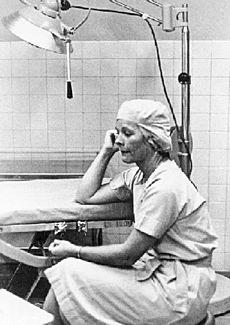
In 1963, LT Bobbi Hovis volunteered to go to Vietnam. She and four other nurses had the tough job of turning a run-down apartment in Saigon into the first U.S. Navy Station Hospital in just four days.
In 1965, George M. Silver became the first man to join the Navy Nurse Corps.
The first four Navy Nurse Corps officers to be injured in combat were in Saigon, Vietnam. LT Ruth Mason, LT Frances Crumpton, LT Barbara Wooster, and LTJG Ann Darby Reynolds were wounded and later received the Purple Heart medal. Navy nurses continued to serve in many places during the Vietnam War. They worked at the Provincial Health Assistance Program, on the hospital ships USS Repose and USS Sanctuary, and at the station hospital in DaNang. The DaNang hospital became the largest combat casualty treatment facility in the world, treating 63,000 patients.
Today, Navy Nurses (about 2,900 of them) are deployed all over the world. They take part in humanitarian missions, helping people in need, and combat support missions. They work with special surgical teams on amphibious assault ships and other Navy vessels. They also serve as flight nurses, on hospital ships, and even with the Marine Corps on the ground. Some Navy nurses also work with the Army and in special operations teams.
For example, in 2006, Commander Lenora C. Langlais was injured by a mortar bomb in Iraq. She was the first African American female and first African American Nurse in Navy history to receive the Purple Heart medal.
Modern Nurse Corps Structure
-
USNS Comfort, a USN hospital ship.
The Nurse Corps is still a very important part of Navy Medicine. Its officers hold ranks from Ensign all the way up to Rear Admiral. People can become Navy Nurse Corps officers through programs like ROTC or by direct commission.
Nurse Corps Insignia and Badges
The Nurse Corps has a special insignia. It is a single Oak Leaf worn on their uniform.
Navy Nurse Corps officers can earn and wear various badges. These include the Fleet Marine Force badge, Surface warfare badge, Basic Parachutist Badge, Air Crew badge, and Flight Nurse warfare badge. Some officers can also wear special warfare insignia. Officers who work as assistants to high-ranking leaders might wear an aiguillette or unique insignia. Navy Nurse Corps officers can also earn the Army Combat Badge, but they are not currently allowed to wear it on their Navy uniform.
Officers who have commanded a Navy base or unit on land can wear the Navy Command Ashore insignia. Those who have commanded a hospital ship can wear the Navy Command at Sea insignia.
From its start in 1908 until 1947, the Navy Nurse Corps was led by a Superintendent. During this time, nurses did not have permanent commissioned ranks. The Army-Navy Nurses Act of 1947 changed this. It made the Navy Nurse Corps a staff corps, and its officers received permanent commissioned ranks from Ensign to Commander. The Corps was then led by a Director, who held the rank of Captain. This position later became a flag-rank appointment, meaning the Director could be a Rear Admiral.
The Navy has named two warships in honor of Navy Nurse Corps officers. Both were named for Superintendent Lenah Higbee:
- USS Higbee, a destroyer commissioned in 1945. This was the first U.S. Navy warship ever named after a female service member.
- USS Lenah H. Sutcliffe Higbee, a planned guided missile destroyer expected to join the fleet in 2024.
Other Ships Named After Nurses
- USS Florence Nightingale
Images for kids


